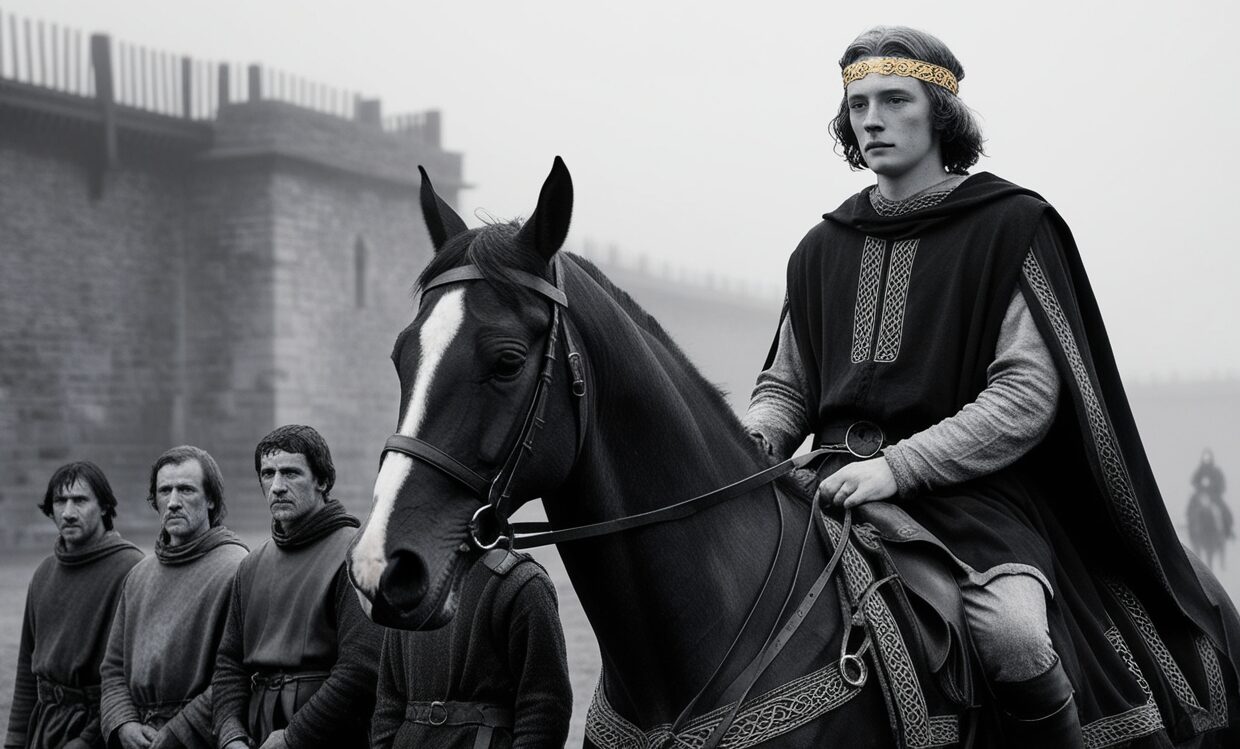In the turbulent years following the Norman Conquest of England in 1066, one figure stands out as a symbol of the last gasps of Anglo-Saxon royal power: Edgar the Aetheling.
Born into the royal line of Wessex, Edgar’s life was destined to be anything but ordinary.
From a brief stint as the uncrowned king of England to his adventures during the First Crusade, Edgar’s story is one of missed opportunities, daring escapes, and ultimately, quiet obscurity.
But who was Edgar the Aetheling, and what became of him after the fateful year of 1066? Let’s dive into the fascinating tale of the last male heir of the House of Wessex.
- 1. Edgar the Aetheling: A Prince in Exile
- 2. The Succession Crisis of 1066
- 3. Edgar the Aetheling: A King for Two Months
- 4. Edgar's Rebellion and Exile
- 5. Edgar the Aetheling's Continental Wanderings
- 6. Reconciliation with William
- 7. Edgar the Aetheling's Italian Adventure
- 8. Supporting Robert Curthose
- 9. Edgar the Aetheling the Diplomat and Warrior in Scotland
- 10. The First Crusade and Pilgrimage
- 11. Edgar the Aetheling's Final Years and Legacy
- Further Reading
1. Edgar the Aetheling: A Prince in Exile
Edgar was born around 1052, far from the shores of England.
His father, Edward the Exile, was the son of Edmund Ironside, a briefly reigning English king. Edward had been sent into exile as a child by King Cnut, who had usurped the English throne.
Growing up in Hungary, Edgar was likely unaware of his claim to the English throne. However, fate had other plans. In 1057, King Edward the Confessor, lacking an heir, invited Edgar’s family back to England.
Tragically, Edgar’s father died shortly after their return, leaving young Edgar as the last male descendant of the royal house of Wessex.
Edgar’s title, “Aetheling,” marked him as a prince of the royal blood and a potential heir to the throne. But at such a young age, he was ill-prepared for the political storm that was brewing.
2. The Succession Crisis of 1066
When Edward the Confessor died in January 1066, Edgar was still in his early teens.
Despite his royal lineage, the Witenagemot – the council of Anglo-Saxon nobles – passed over Edgar in favor of the more mature and militarily capable Harold Godwinson.
Edgar’s youth and lack of powerful allies meant he was sidelined during one of the most crucial years in English history. As Harold Godwinson was focused on fighting off the invasions by Harald Hardrada of Norway and William of Normandy, Edgar watched from the sidelines.
3. Edgar the Aetheling: A King for Two Months

After Harold’s death at the Battle of Hastings in October 1066, some Anglo-Saxon leaders rallied around Edgar. In a desperate attempt to resist the Norman invasion, they proclaimed the teenage Edgar as king.
For a brief moment, it seemed that the House of Wessex might retain the crown. Edgar had the support of the Archbishops of Canterbury and York, as well as the powerful Earls Edwin of Mercia and Morcar of Northumbria.
But Edgar’s reign, if it can be called that, was short-lived.
As William of Normandy advanced on London, Edgar’s supporters began to lose heart. By December, it was clear that resistance was futile.
In a pragmatic move, Edgar’s supporters decided to submit to William.
The uncrowned teenage king was taken to meet William at Berkhamsted, where he paid homage to the Conqueror.
William, perhaps seeing Edgar as more valuable alive than dead, treated the young Aetheling with a measure of respect. Edgar was even taken to Normandy as part of William’s entourage in 1067, perhaps as a way for the new king to keep an eye on his potential rival.
4. Edgar’s Rebellion and Exile
Despite initially accepting Norman rule, Edgar soon found himself drawn into rebellion.
In 1068, he may have been involved in the unsuccessful revolt led by Earls Edwin and Morcar.
Sensing the changing tide, Edgar fled to Scotland with his mother and sisters. There, they found refuge at the court of King Malcolm III. Malcolm, recognizing the political advantage of aligning with the English royal house, married Edgar’s sister Margaret.
Malcolm’s support gave Edgar new hope. In 1069, the young Aetheling returned to England to lead a rebellion in Northumbria. Initially successful, Edgar’s forces captured York, but he was soon defeated by William.
Later that year, in support of a Danish fleet, Edgar retook York, but the adventure ended in disaster, and he narrowly escaped capture.
William’s response to this rebellion was swift and brutal.
In what became known as the Harrying of the North, William devastated Northumbria, burning crops and villages, and causing widespread famine.
In 1070, Edgar with other Anglo-Saxon nobles had taken refuge in Ely. William would once again pursue Edgar, and he would once again return to the Scottish court.
5. Edgar the Aetheling’s Continental Wanderings
For the next few years, Edgar’s life was marked by constant movement. He spent time in Scotland, Flanders, and even attempted to establish himself in France.
In 1074, Edgar accepted an offer from King Philip I of France to settle near the Norman border.
However, his ship was wrecked on the English coast. In a stroke of luck, Edgar managed to escape to Scotland by land, while many of his followers were captured.
6. Reconciliation with William
Tired of constant conflict and exile, Edgar finally made peace with William in 1074. He returned to England as William’s subject, seemingly giving up his royal ambitions.
For several years, Edgar lived quietly in England. He even participated in William’s campaign in South Wales in 1081. However, his position at the Norman court was far from the royal status he might have expected as an Aetheling.
7. Edgar the Aetheling’s Italian Adventure
Dissatisfied with his treatment, Edgar embarked on a new adventure in 1086. He traveled to Norman-controlled Apulia in southern Italy, perhaps hoping to carve out a new future for himself.
This Italian sojourn was short-lived, however. Within a few years, Edgar was back in England.
The Domesday Book of 1086 records him as owning only two small estates in Hertfordshire, a far cry from the vast lands his royal ancestors once held.
8. Supporting Robert Curthose
When William the Conqueror died in 1087, the Norman realm was divided between his sons. Robert Curthose received Normandy, while William Rufus became King of England.
Edgar, perhaps hoping to improve his fortunes, sided with Robert in the ensuing power struggle. He became one of Robert’s principal advisers, but this decision would prove costly.
When Robert’s attempt to seize the English throne failed in 1091, Edgar found himself deprived of the lands he had been granted in Normandy. Once again, he sought refuge in Scotland.
9. Edgar the Aetheling the Diplomat and Warrior in Scotland
Edgar’s connection to the Scottish royal family through his sister Margaret made him a valuable intermediary between the English and Scottish courts.
In 1091, he helped negotiate a peace treaty between William Rufus and Malcolm III.
However, peace was short-lived. In 1093, Edgar was sent on a diplomatic mission to Scotland to address Malcolm’s dissatisfaction with the implementation of the treaty. This mission ended in tragedy when Malcolm and his eldest son were killed invading England shortly after.
The resulting succession crisis in Scotland drew Edgar back into conflict.
In 1097, he led an invading army into Scotland on behalf of the Norman king. This time, Edgar was successful, deposing Donald Bane and installing his own nephew (also named Edgar) on the Scottish throne.
10. The First Crusade and Pilgrimage
Around the turn of the century, Edgar’s life took another unexpected turn. Some sources suggest he participated in the First Crusade, possibly commanding an English fleet off the coast of Syria.
While his exact role in the Crusade is debated, we know that Edgar made a pilgrimage to Jerusalem in 1102.
On his return journey, he reportedly received rich gifts from both the Byzantine and German emperors, each offering him a place at their court. Edgar, however, chose to return to England.
11. Edgar the Aetheling’s Final Years and Legacy
Edgar’s last major political act was to support Robert Curthose once again, this time against Henry I of England. This decision led to his capture at the Battle of Tinchebray in 1106. However, Henry pardoned Edgar, perhaps influenced by the fact that Henry’s wife Edith (later renamed Matilda) was Edgar’s niece.
After this final adventure, Edgar retired from public life.
William of Malmesbury, writing in 1125, reported that Edgar “now grows old in the country in privacy and quiet.” The exact date and location of Edgar’s death are unknown.
Edgar’s legacy is a complex one.
As the last male heir of the House of Wessex, he represented the end of an era in English history. His life story reads like an adventure novel, full of rebellions, exiles, and narrow escapes.
Yet for all his royal blood and youthful promise, Edgar never managed to secure the throne that many believed was rightfully his.
Perhaps Edgar’s most lasting impact was through his sister Margaret. Her marriage to Malcolm III of Scotland created a connection between the old English royal line and the Scottish monarchy.
Edgar the Aetheling’s story serves as a poignant reminder of the dramatic changes brought about by the Norman Conquest.
In many ways, he embodied the struggle of Anglo-Saxon England against Norman rule. His eventual quiet retirement symbolizes the final integration of the old and new orders in England.
From a potential king to a crusader, from a rebel to a kingmaker in Scotland, Edgar lived a life few could have predicted. His journey through one of the most turbulent periods of English history provides us with a fascinating glimpse into the complex world of medieval politics and power.
Further Reading
If you enjoyed this article, you may enjoy these:
- Kings and Queens of England Ranked from Worst to Best
- Why was Lady Jane Grey accused of treason?
- How did Charlemagne improve the lives of people in Europe?
- Why was the crowning of Charlemagne so important?
- Were the Princes in the Tower bodies ever found?
- How President Andrew Jackson Caused the Economic Crisis of 1837
- Why did General Robert E. Lee surrender at Appomattox?
You may also enjoy these articles about Medieval Europe:







